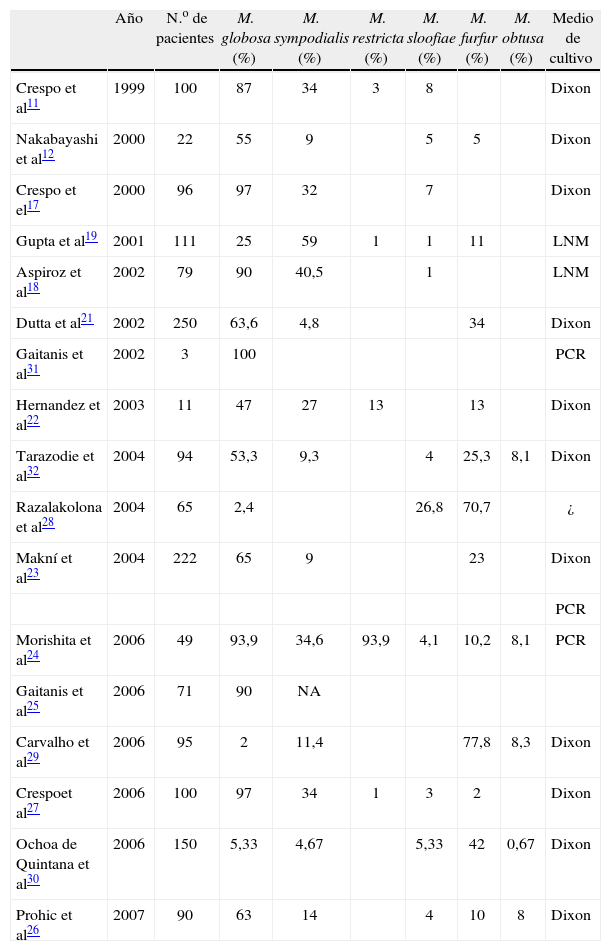Este estudio analiza la prevalencia de las especies del género Malassezia en las lesiones de pacientes con pitiriasis versicolor, así como en la piel sana de sujetos sin pitiriasis versicolor.
Material y métodosEn 150 pacientes con pitiriasis versicolor se obtuvieron muestras de las lesiones con papel adhesivo transparente para el exámen directo al microscopio utilizando hidróxido potásico al 20% mezclado con tinta Parker azul negra. Además, se obtuvieron muestras por raspado de las lesiones, que se sembraron en medio de Dixon modificado para su cultivo. En cada uno de los 150 sujetos sin pitiriasis versicolor se obtuvieron muestras de piel sana de la frente y de los hombros mediante frotamiento con hisopo estéril y se destinaron a cultivo en el medio de Dixon, sin realizar exámen directo al microscopio. Las distintas especies de Malassezia se identificaron según sus características macro y microscópicas y los resultados de los test fisiológicos.
ResultadosM. globosa fue la especie predominantemente aislada en 130 casos (86,7%) de los 150 con pitiriasis versicolor, seguida por M. sympodialis en 63 casos (42%). En la piel sana de la frente de sujetos sin pitiriasis versicolor fueron positivas 23 (15,3%) de las 150 muestras. La especie predominantemente aislada fue M. sympodialis en el 56,52% de los casos, seguida de M. globosa en el 47,8%. En la piel sana de los hombros, 91 (60,6%) de las 150 muestras fueron positivas. La especie predominante en los cultivos fue con diferencia M. sympodialis (91,2%) seguida de M. globosa (7,6%) y M. slooffiae (1,09%).
ConclusiónM. globosa, en su fase micelial, es el principal agente etiológico de la pitiriasis versicolor.
This study analyses the prevalence of Malassezia species in the skin lesions of patients with pityriasis versicolor and in the healthy skin of a healthy individual group.
Materials and MethodsThe group studied included one hundred and fifty patients with pityriasis versicolor. Samples were taken from the pityriasis versicolor lesions by means of Sellotape for direct microscopy with KOH + Parker ink, and scales were obtained by scarping for culture, and inoculated on modified Dixon agar plates. Samples were also taken of healthy skin of the forehead and of the shoulders of one hundred and fifty healthy individual group.
All these samples were used for culture and inoculated on the medium, but were not examined by direct microscopy. The yeasts were identified by their morphological and physiological characteristics.
ResultsM. globosa was isolated in 130 cases (86,7%) of 150 patients with pityriasis versicolor. M. sympodialis was also found in 63 cases (42%). In healthy skin of the forehead of healthy individuals a total of 23 isolates from the 150 samples were obtained. M. sympodialis was the predominant species (56,52%), followed by M. globosa (47,8%).
In healthy skin of the shoulders a total of 91 isolates were obtained. M. sympodialis was by far the predominant species (91,2%) followed by M. globosa (7,6%) and M. slooffiae (1,09%).
ConclusionsM. globosa, in its mycelial phase, is the predominant species in the ethiology of pityriasis versicolor.
Artículo
Comprando el artículo el PDF del mismo podrá ser descargado
Precio 19,34 €
Comprar ahora













